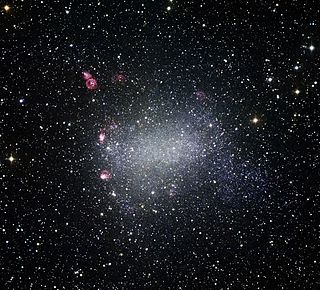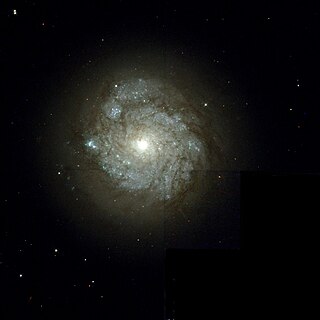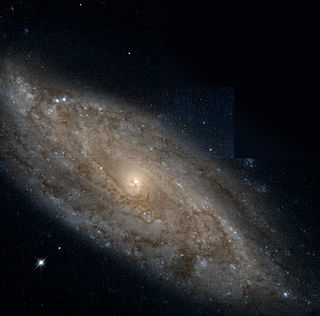Related Research Articles

Sandra Moore Faber is an astrophysicist known for her research on the evolution of galaxies. She is the University Professor of Astronomy and Astrophysics at the University of California, Santa Cruz, and works at the Lick Observatory. She has made important discoveries linking the brightness of galaxies to the speed of stars within them and was the co-discoverer of the Faber–Jackson relation. Faber was also instrumental in designing the Keck telescopes in Hawaii.
Professor Annette Mairi Nelson Ferguson FRSE is a Scottish observational astrophysicist who specialises in the area of galaxy evolution. She is a professor at the Institute for Astronomy, Edinburgh, and holds the Personal Chair in Observational Astrophysics at the School of Physics and Astronomy, University of Edinburgh.

A dwarf galaxy is a small galaxy composed of about 1000 up to several billion stars, as compared to the Milky Way's 200–400 billion stars. The Large Magellanic Cloud, which closely orbits the Milky Way and contains over 30 billion stars, is sometimes classified as a dwarf galaxy; others consider it a full-fledged galaxy. Dwarf galaxies' formation and activity are thought to be heavily influenced by interactions with larger galaxies. Astronomers identify numerous types of dwarf galaxies, based on their shape and composition.

NGC 5195 is a dwarf galaxy that is interacting with the Whirlpool Galaxy. Both galaxies are located approximately 25 million light-years away in the constellation Canes Venatici. Together, the two galaxies are one of the most famous interacting galaxy pairs.

The Sculptor Dwarf Irregular Galaxy (SDIG) is an irregular galaxy in the constellation Sculptor. It is a member of the NGC 7793 subgroup of the Sculptor Group. The galaxy was discovered in 1976.

NGC 6822 is a barred irregular galaxy approximately 1.6 million light-years away in the constellation Sagittarius. Part of the Local Group of galaxies, it was discovered by E. E. Barnard in 1884, with a six-inch refractor telescope. It is one of the closer galaxies to the Milky Way. It is similar in structure and composition to the Small Magellanic Cloud. It is about 7,000 light-years in diameter.

NGC 278 is an isolated spiral galaxy in the northern circumpolar constellation of Cassiopeia, near the southern constellation boundary with Andromeda. It lies at a distance of approximately 39 megalight-years from the Milky Way, giving it a physical scale of 190 ly (58 pc) per arcsecond. The galaxy was discovered on December 11, 1786 by German-born astronomer William Herschel. J. L. E. Dreyer described it as, "considerably bright, pretty large, round, 2 stars of 10th magnitude near".

NGC 7314 is a spiral galaxy located in the southern constellation of Piscis Austrinus. It was discovered by English astronomer John Herschel on July 29, 1834. This is a nearby Seyfert (active) galaxy, located at a distance of approximately 54.6 megalight-years from the Milky Way. Since it appears to have detached spiral arm segments, it was listed in Halton Arp's Atlas of Peculiar Galaxies.

Dr. Kimberly A. Weaver is an American astrophysics astronomer and professor. She has worked with NASA on several research projects. She is often seen on television programs about astronomy. She is an expert in the area of x-ray astronomy.

Alicia Margarita Soderberg is an American astrophysicist who is an assistant professor of Astronomy at Harvard University and a postdoctoral fellow at the Harvard–Smithsonian Center for Astrophysics whose research focuses on supernovae.
Carolin Susan Crawford is a British communicator of science and astrophysicist. She is an emeritus member of the Institute of Astronomy, Cambridge and a supernumerary fellow of Emmanuel College, Cambridge.
Neta Bahcall is an Israeli astrophysicist and cosmologist specializing in dark matter, the structure of the universe, quasars, and the formation of galaxies. Bahcall is the Eugene Higgins Professor of Astronomy at Princeton University.
Prajval Shastri is an astrophysicist at the Indian Institute of Astrophysics, Bangalore and specializes in the area of phenomenology of active galaxies driven by supermassive blackholes using multi-wavelength observations ranging from radio to X-ray wavelengths.
Marie E. Machacek is an astrophysicist conducting research in the High Energy Astrophysics Division of the Smithsonian Astrophysical Observatory. She earned a BA in physics and mathematics from Coe College, in 1969; an MS in physics from the University of Michigan, in 1970; and a PhD in physics from the University of Iowa, in 1973. Her current research explores interacting galaxies and the evolution of galaxies in galaxy groups and clusters. She is also the current coordinator for the SAO Astronomy Intern Program.

Smadar Naoz is an Israeli-American astrophysicist, and was the 2015 winner of the Annie Jump Cannon Award in Astronomy for her scientific contributions to the fields of cosmology and planetary dynamics.
Sabrina Stierwalt is an American extragalactic astrophysicist who studies gas dynamics and the formation and evolution of galaxies through surveys utilizing x-ray, ultraviolet, optical, infrared, submillimeter, and radio wavelengths. She is experienced in science communication and advocating for equality and equity for underrepresented groups in science, technology, engineering, and mathematics (STEM) fields.

NGC 694 is a spiral galaxy approximately 136 million light-years away from Earth in the constellation of Aries. It was discovered by German astronomer Heinrich Louis d'Arrest on December 2, 1861 with the 11-inch refractor at Copenhagen.
Carmelle Robert is a Quebec astrophysicist, starburst researcher and professor at the Department of Physics, Physical Engineering and Optics at Université Laval, in Québec city, Canada.
Jean L. Turner is an astrophysicist and distinguished professor in the Department of Physics and Astronomy at the University of California, Los Angeles. She was lead author on research and discovery of a particular star cluster in the dwarf galaxy NGC 5253, considered 'remarkable' for being an extremely dusty gas cloud and having highly efficient star formation.
Linda Jean Tacconi–Garman is a senior scientist at the Max Planck Institute for Extraterrestrial Physics.
References
- ↑ Kayser, Susan Elizabeth (1966). Photometry of the nearby irregular galaxy, NGC 6822 (Ph.D.).
- ↑ Jesse Greenstein (1997). "Astronomy at California Institute of Technology". In John Lankford (ed.). History of Astronomy: An Encyclopedia. p. 106. ISBN 9780815303220.
- ↑ "Astrophysicists Getting Prettier". The Free Lance-Star. Fredericksburg, VA. Dec 9, 1966. Retrieved March 15, 2016.
- ↑ "Astrophysicists Getting Prettier". The Daily Telegram. Eau Claire, Wisconsin. December 15, 1966. Retrieved September 22, 2016.
- ↑ "Astrophysicists Getting Prettier". Standard-Speaker. Hazleton, PA. January 12, 1967. Retrieved March 15, 2016.
- ↑ "New Image Shows Rich Neighborhood of Nearby Galaxy".
- ↑ "A Meeting of Hearts and Minds at the STS".